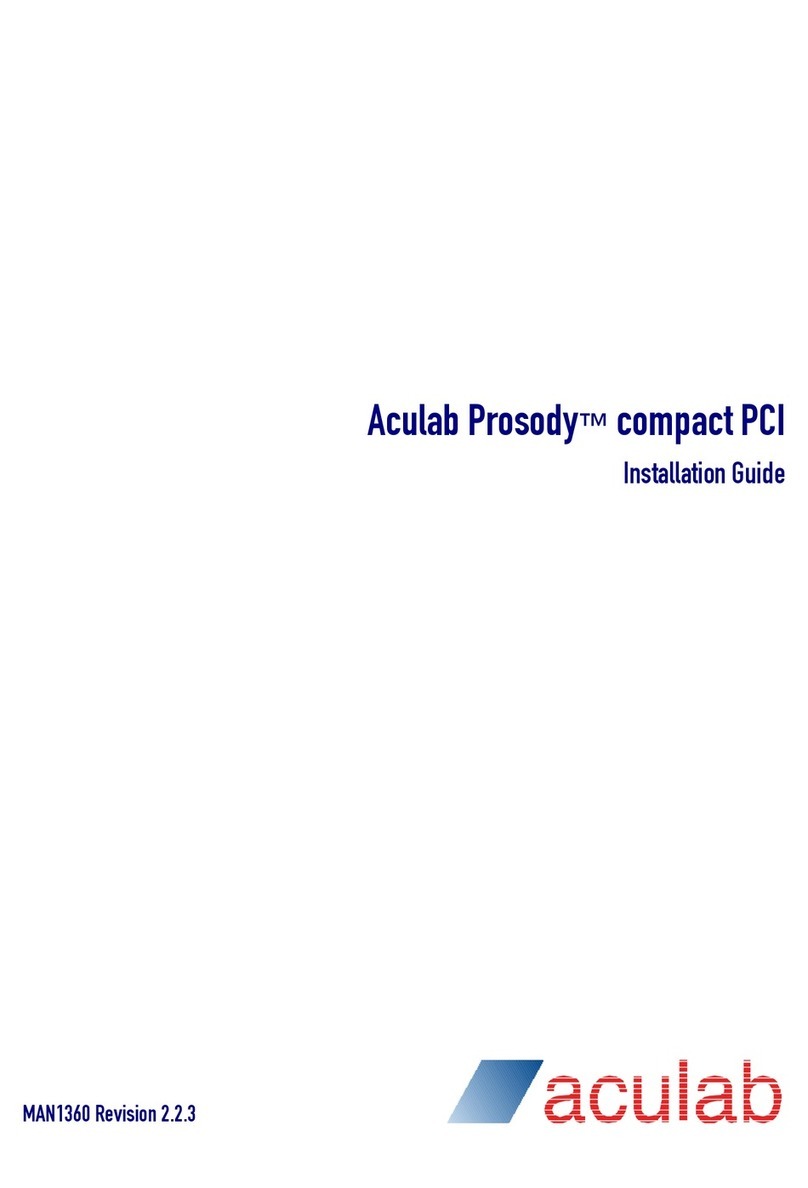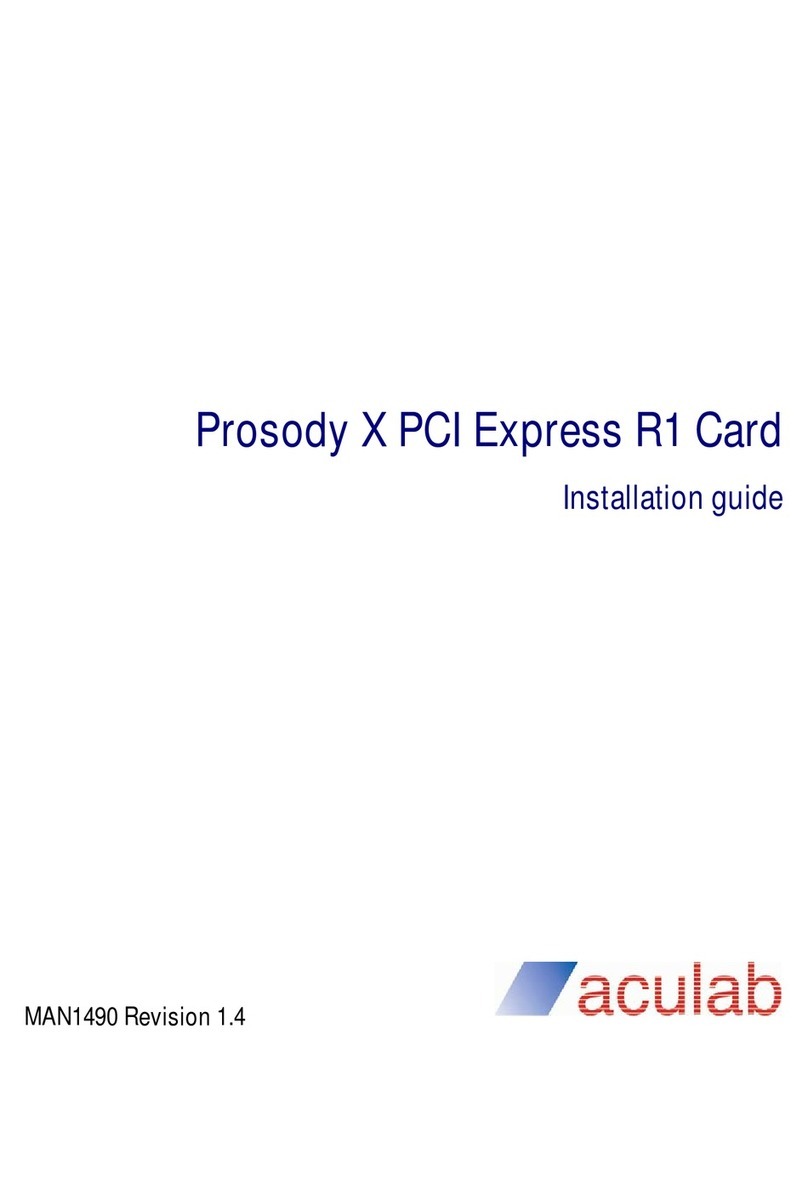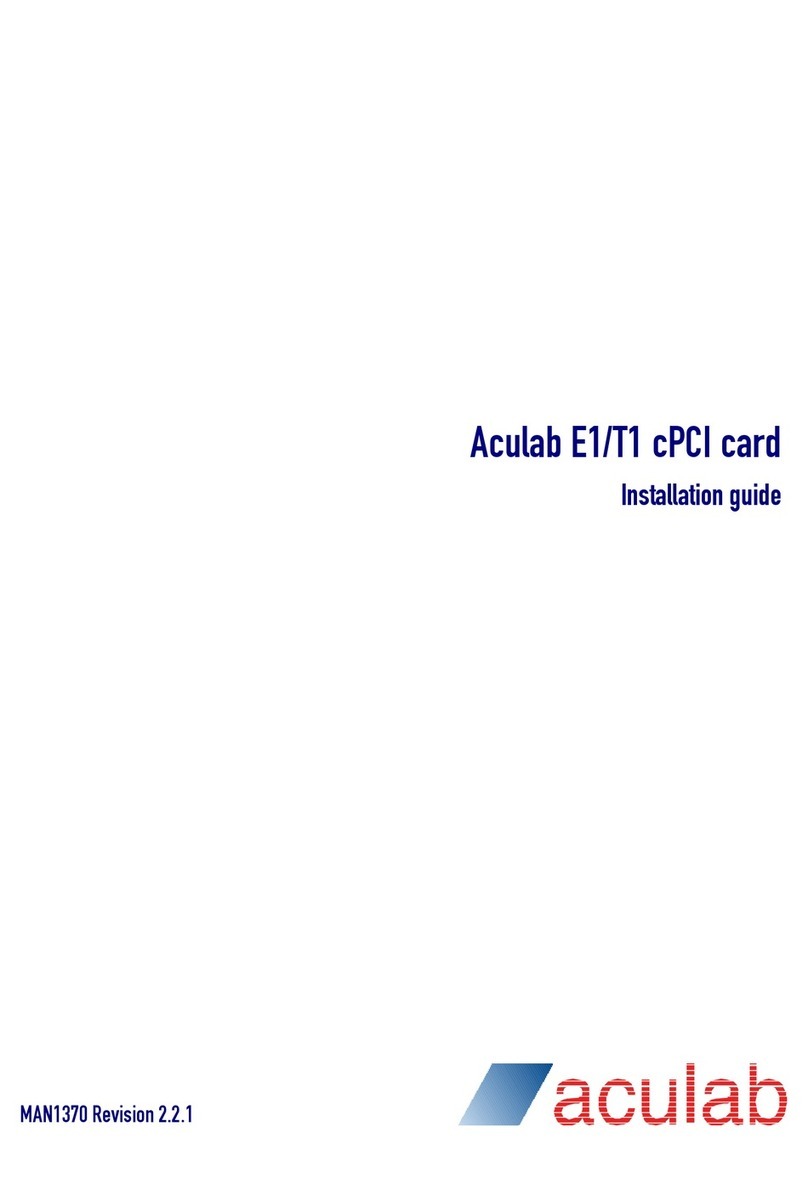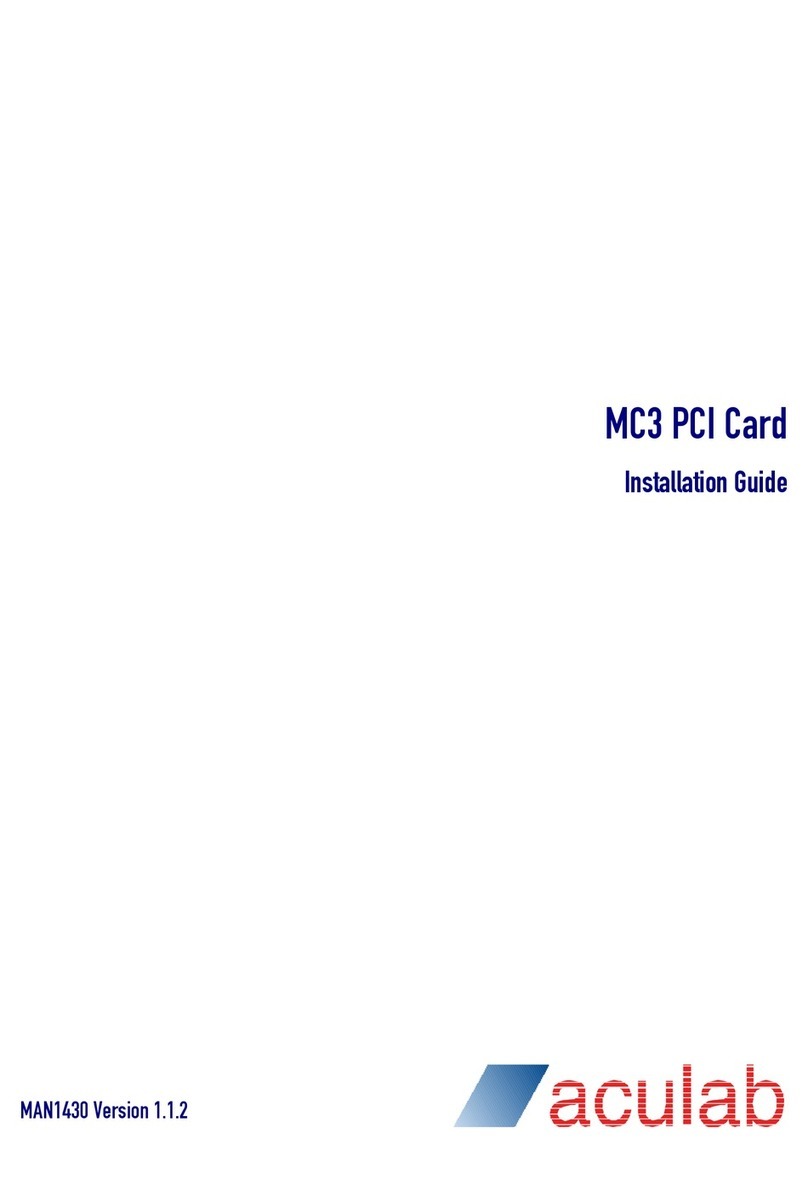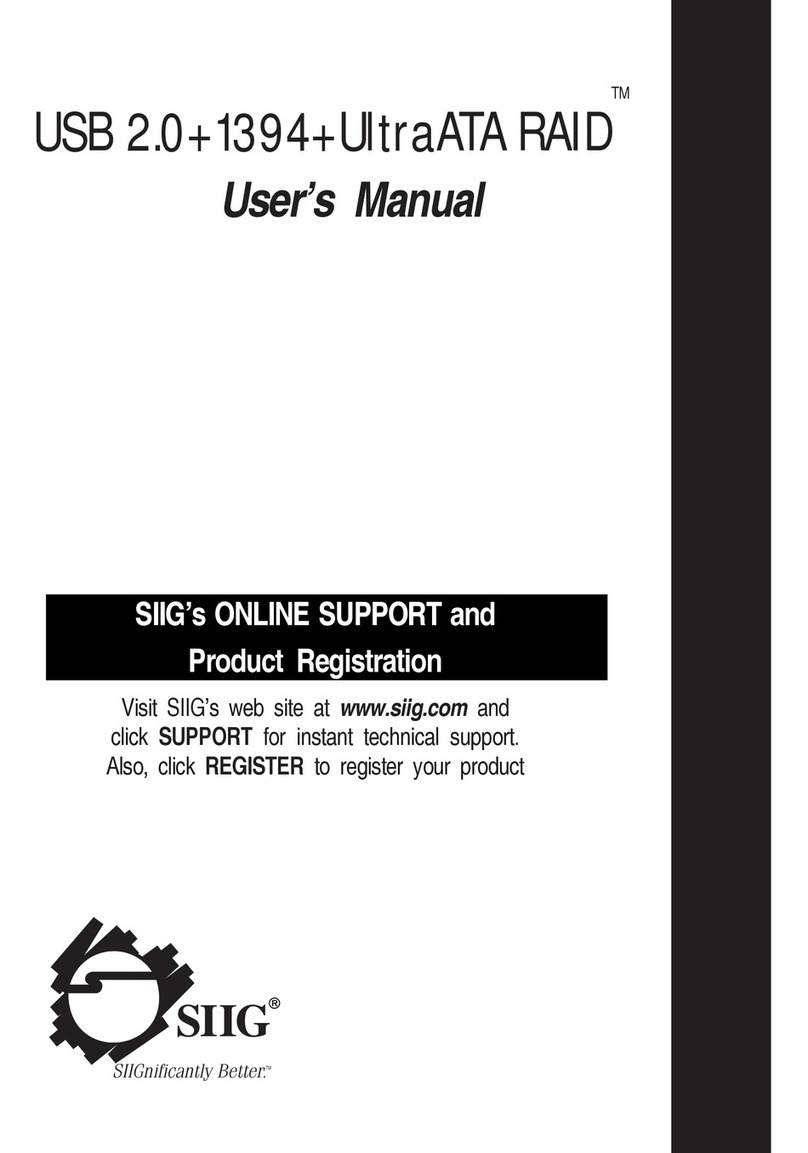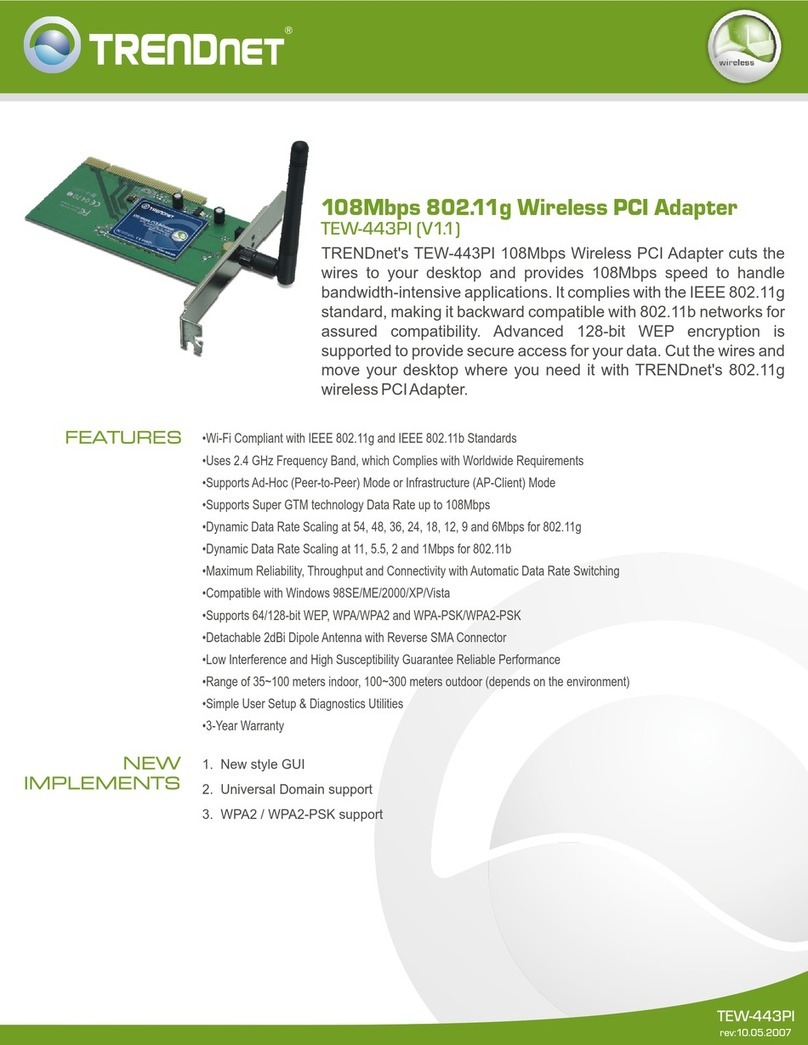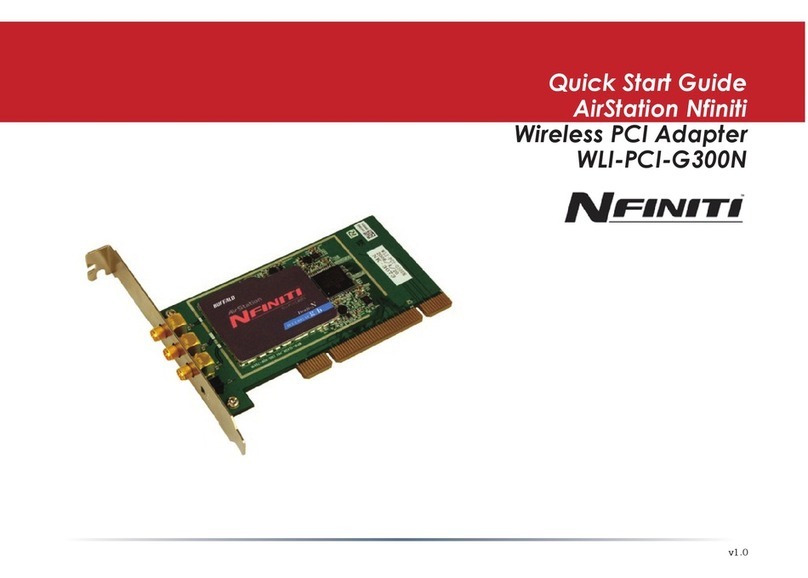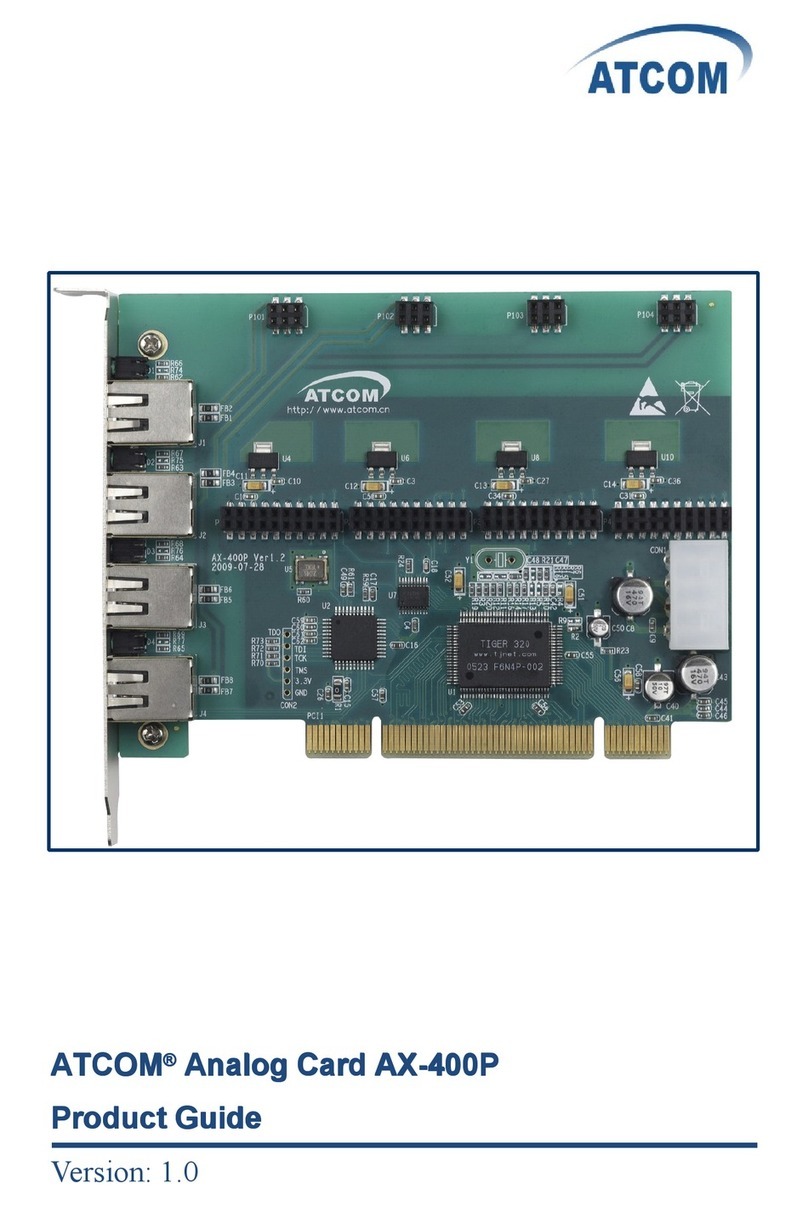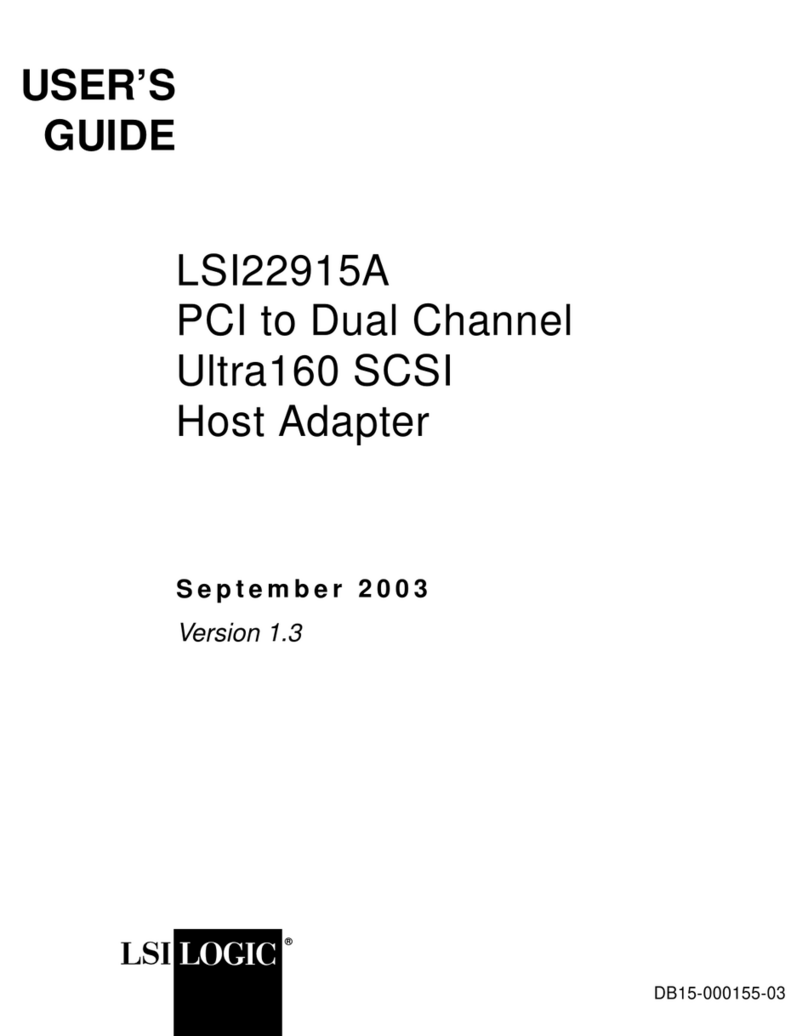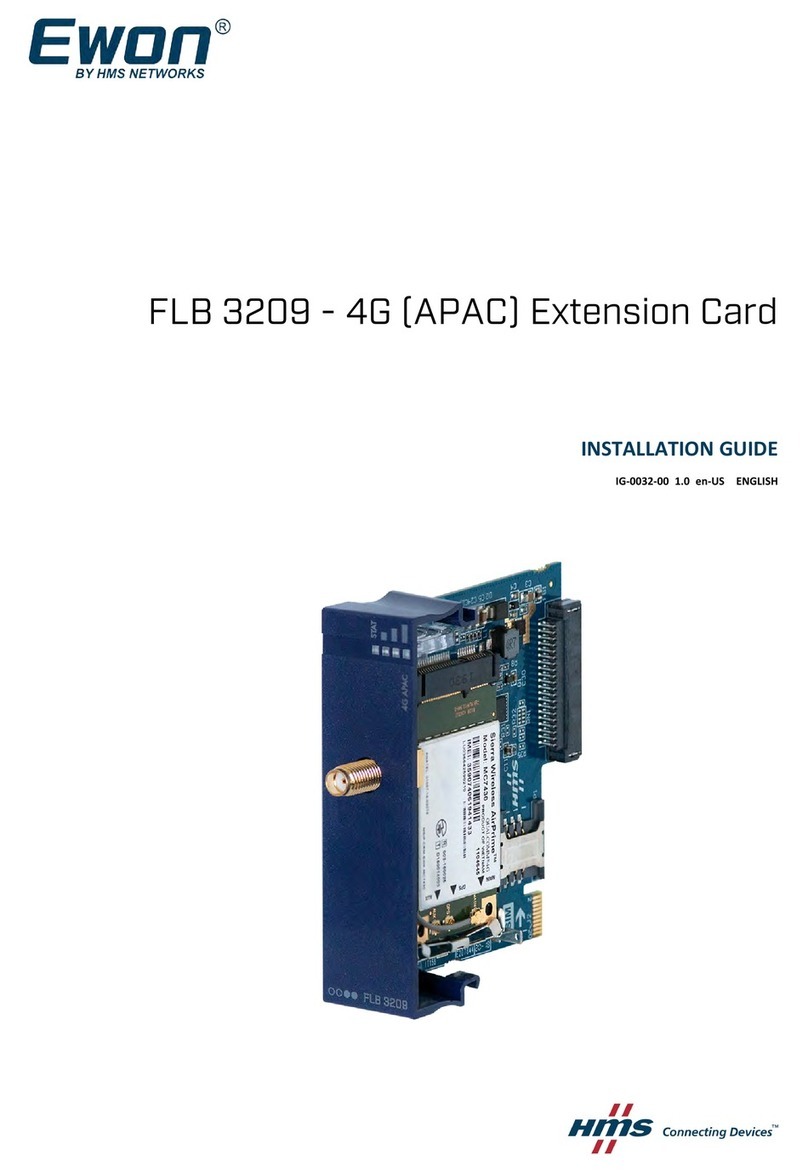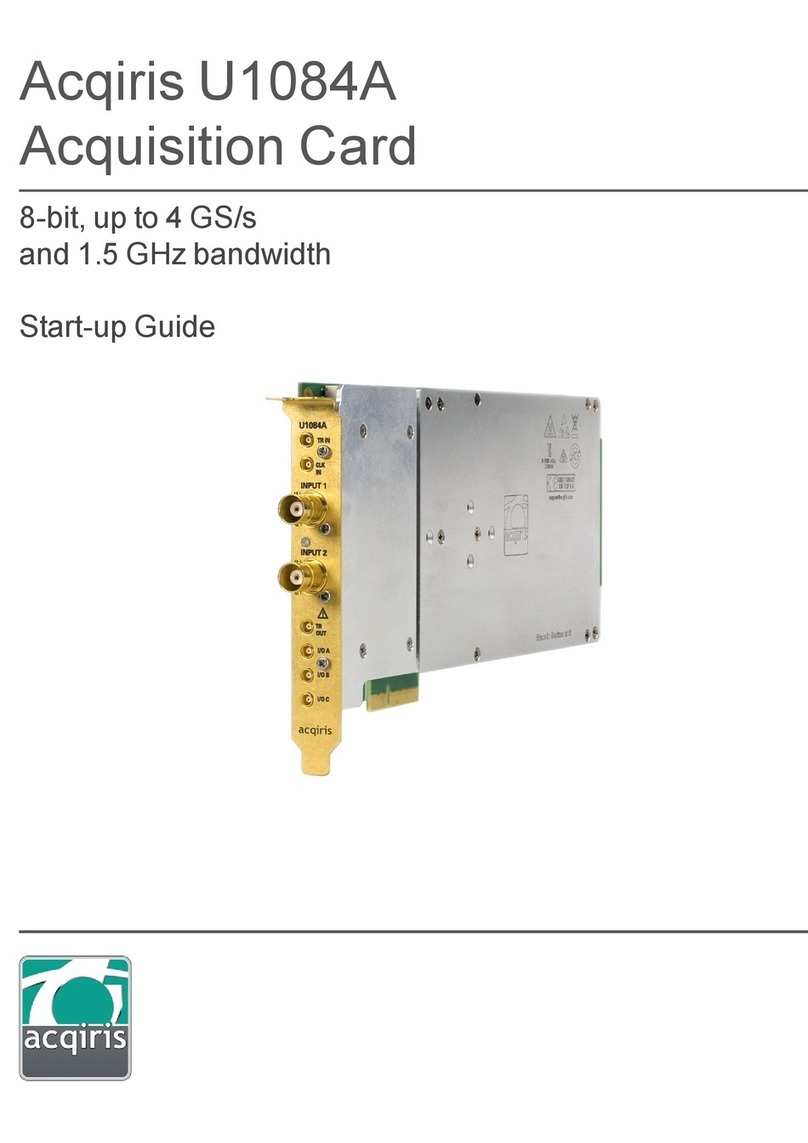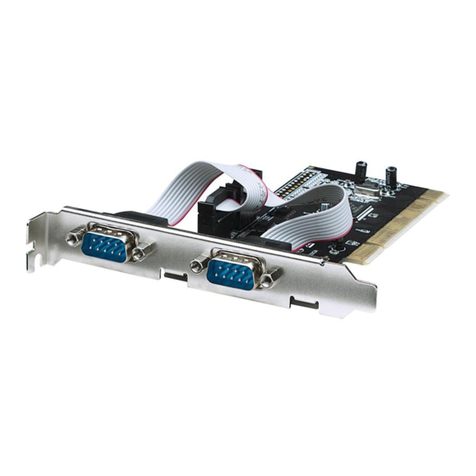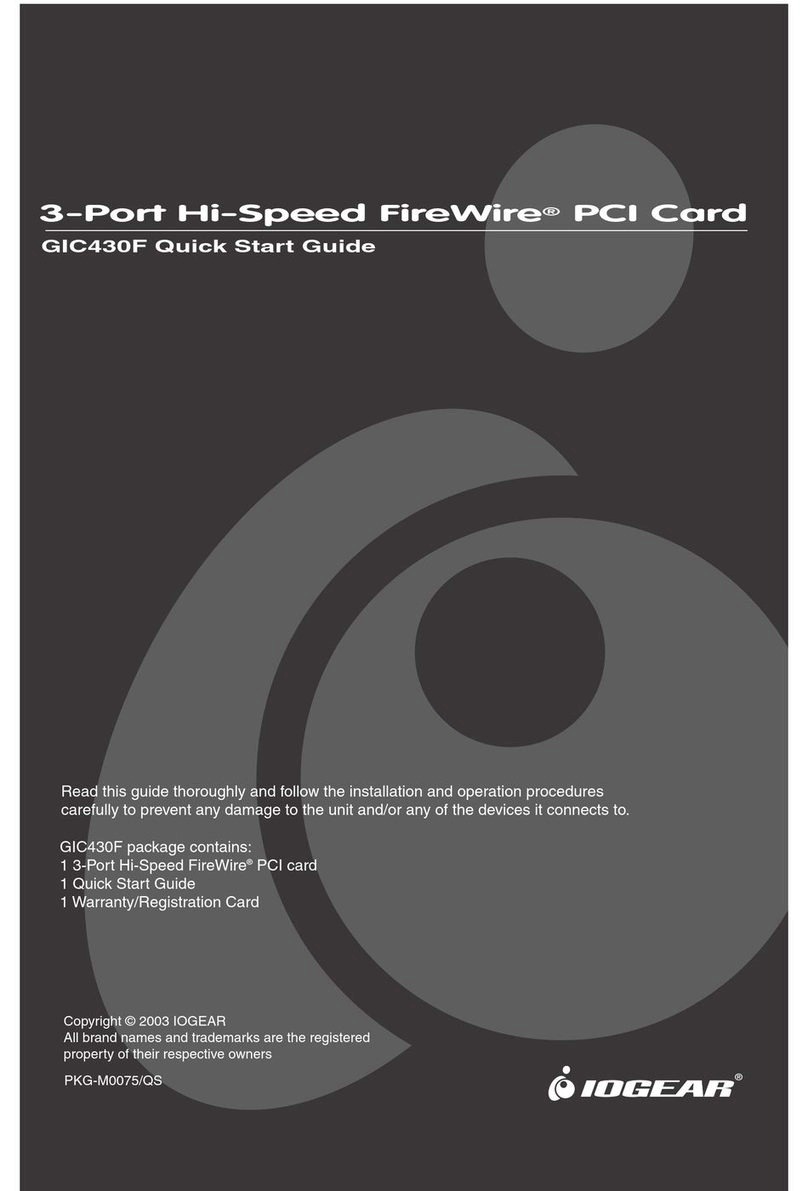aculab E1 User manual

MAN 1350 Revision 2.2.2
Aculab E1/T1 PCI card
Installation guide

E1/T1 PCI card installation guide
2
PROPRIETARY INFORMATION
The information contained in this document is the property of Aculab Plc and may be the
subject of patents pending or granted, and must not be copied or disclosed without prior written
permission. It should not be used for commercial purposes without prior agreement in writing.
All trademarks are recognised and acknowledged.
Aculab Plc endeavours to ensure that the information in this document is correct and fairly
stated but does not accept liability for any error or omission.
The development of Aculab products and services is continuous and published information may
not be up to date. It is important to check the current position with Aculab Plc.
Copyright © Aculab plc. 2000: All Rights Reserved.
Document Revision
Rev’ Date By Detail
1.0 Mar 2000 DMB First release
1.1 May 2000 DMB Addition of Legacy Adaptor details
1.2 Dec 2000 DMB Addition of Japanese Approval details & inclusion of EU/UK
Declaration of Conformance to Type
1.3 Feb 2001 DJL Addition of Japanese translation and UL requirement
1.4 Aug 2001 DJL Hardware changes — termination LED, PM4 etc
1.5 Nov 2001 DJL Minor changes + new Glossary of abbreviations.
1.6 Jan 2003 DJL Clarification on E1 75ohms
2.0 June 2003 DJL Introduction of revision 2 PM information
2.1 July 2003 DJL Clarification on the use of Ferrites
2.2 Dec 2003 DJL Clarification on PM LED state during reset
2.2.1 Feb 2004 DJL Clarification on front LEDs
2.2.2 Mar 2004 DJL Addition of DSP65 information

E1/T1 PCI card installation guide
3
CONTENTS
1Introduction............................................................................................................................... 4
1.1 General............................................................................................................................. 4
1.2 Uses of the E1/T1 PCI card................................................................................................ 5
1.3 Telephone Network Attachment ....................................................................................... 6
1.4 Call Control ...................................................................................................................... 6
1.5 Speech and Data Paths ..................................................................................................... 6
1.6 H.100 CTBus termination ................................................................................................. 7
1.7 H.100 CTBus loading........................................................................................................ 7
1.8 E1/T1 PCI card - Host Interface......................................................................................... 7
2Card Installation...................................................................................................................... 8
2.1 Installing the Card.............................................................................................................8
2.2 Installation der Karte......................................................................................................... 8
2.3 Installation de la carte....................................................................................................... 8
2.4 Installing/upgrading modules............................................................................................ 9
2.4.1 Removing an existing card:................................................................................... 9
2.4.2 Removing an existing module:.............................................................................. 9
2.4.3 Installing modules:................................................................................................ 9
2.4.4 Installing a card into a host: ................................................................................ 10
2.5 75 ohm network connection........................................................................................... 10
2.6 Prosody PCI card endplate LED usage............................................................................. 11
2.7 PM module LED usage.................................................................................................... 11
3Approval Information........................................................................................................ 12
3.1 Safety Warnings.............................................................................................................. 12
3.2 EMC Compliance............................................................................................................ 12
3.3 Approval Details............................................................................................................. 12
3.4 Usage and Type.............................................................................................................. 12
3.5 Environmental................................................................................................................. 12
3.6 Network Timing.............................................................................................................. 13
3.7 Power Supply.................................................................................................................. 13
3.8 Regulatory Warnings....................................................................................................... 13
3.9 Approved Functionality & Label...................................................................................... 13
3.10 Documentation Release.................................................................................................. 13
3.11 Software Release............................................................................................................. 13
3.12 User Responsibilities....................................................................................................... 14
3.13 Speech Calls ................................................................................................................... 14
Appendix A: Country Specific Information.............................................................. 15
Appendix B: USA/Canada Approval Details........................................................... 16
Appendix C: Approval Details For European Union Countries & UK.. 20
Appendix D: Approval details for Australia............................................................ 26
Appendix E: Technical Specifications......................................................................... 28
Appendix F: Aculab Ferrite Clamp fitting instructions..................................... 29
Glossary of abbreviations:................................................................................................... 30

E1/T1 PCI card installation guide
4
1 Introduction
This introductory section of this document provides a general description of the E1/T1 PCI card,
it's features and facilities.
1.1 General
This document is the installation and user guide for the Aculab E1/T1 PCI card. There are three
variants of the E1/T1 PCI card, with one (PM1), two (PM2) or four (PM4) Primary Rate Line
Interfaces (ports) on an interchangeable Line Interface Module (LIM). Up to two optional
signalling DSP modules can be added when additional resources are needed, for example, to
support CAS protocols, DTMF and call progress tones, etc.
DSP module A DSP module BPM1, 2 or 4
H.100 CT Bus
PCI Bus interface
The Aculab E1/T1 PCI card shown with line interface unit (LIM) and optional digital signal processor (DSP) modules
This product is referred to as the ‘E1/T1 PCI card’ in this document unless the context requires a
more specific term.
The serial number of the E1/T1 PCI card is used when configuring the device driver to uniquely
identify the E1/T1 PCI card in the system. The serial number of the card is located on the reverse
of the card (no components) on the top edge and has the format P/N ACXXXX S/N XXXX
WONXXX. Only the 'number' following S/N is used during driver configuration, the other
numbers are for Aculab use.
DSPs
The above diagram shows optional DSPs fitted to the base card, there are two versions of the
DSP that may be fitted to the E1/T1 PCI card, the DSP 32 or the DSP 65.
DSP32 DSP65
CAUTION You may not fit a DSP32 and a DSP65 to the same card. Pre revision 2 PM cards can support one DSP65 or up to two DSP32s. Revision
2 or later cards can support two DSP32s or two DSP65s.

E1/T1 PCI card installation guide
5
In most instances the functionality of both DSPs is the same. One exception however is when
using the DSP 65 for tone based CAS protocols. In this instance the following additional DSP
firmware file needs to be downloaded to the DSP65:
acasa.b65 for a-law
acasu.b65 for u-law
For all other functions, such as with tone detection, the file name suffix denotes the firmware file
to be used. For example:
cpdtmfu.bin for u-law tone detection on a DSP32
cpdtmfu.b65 for u-law tone detection on a DSP65
See the Aculab Call switch and speech driver guide for further details on using the DSP
resources.
The Card Installation & Connection section refers to installation of the E1/T1 PCI card into a host
computer, hardware control and configuration information, and subsequent connection to the
network.
The Approval Information section, in conjunction with the country-specific appendices, gives the
conditions of the Approval for connection to the telephone network, requirements for installation
and safety, and other regulatory matters. This section and the appropriate country-specific
appendices contain statements regarding the use of the E1/T1 PCI card that are legal
requirements for connection to the public network. Failure to use the E1/T1 PCI card in
accordance with any of these instructions for use may invalidate the approval for connection.
Call and Switch control functions are provided via one of several device drivers that are
described in separate specific publications.
The card is not a complete product, and only has usable functionality when associated with a
host computer and an application program.
These instructions for use assume that these various elements are being assembled and
integrated by someone competent in such matters. Please contact Aculab support if you are
unsure of any issues arising from the use of the Aculab PCI card. Contact details may be found
on the company web site at www.aculab.com
1.2 Uses of the E1/T1 PCI card
The E1/T1 PCI card is a plug-in card suitable for use in many different types of PCI compatible
computer. Up to four E1/T1 primary rate ports are installed on a plug-in Line Interface Module
(LIM) providing a means of connection to a digital telephone network. The four port LIM is
referred to as the PM4 (Primary rate Module 4 port), the two port LIM is referred to as the PM2
and the single port LIM is referred to as the PM1.
The E1/T1 PCI card provides an ECTF H.100 CTBus port that allows interconnection with a very
wide range of third-party products. The E1/T1 PCI card contains a digital switch matrix that
allows arbitrarily switched interconnection between up to 120 channels on the E1-network or 92
channels on the T1-network or 4096 speech paths (timeslots or channels) on the H.100 CTBus.
Control of the E1/T1 PCI card is via a low-level interface ported to the PCI bus. The card is
essentially operating system independent, and may be used in a Windows NT/2000, Linux, or
indeed any other operating system environment using a suitable device driver. Please contact
Aculab plc for information on current device driver availability.

E1/T1 PCI card installation guide
6
1.3 Telephone Network Attachment
The E1/T1 PCI card with a revision 1.5 E1 PM1/2/4 Line Interface Module fitted, attaches to the
2Mbit digital system or Primary Rate (2.048 Mbit/s) Integrated Services Digital Network (ISDN).
Network attachment is via a service provision often used to connect digital PBXs to the
telephone network (NT1). It is available with 1, 2 or 4 primary rate ISDN ports and so may make
or receive 30, 60 or 120 separate calls at a time.
The E1/T1 PCI card with a revision 1.5 T1 PM1/2/4 Line Interface Module fitted, attaches to the
1.544Mbit digital system via a Channel Service Unit (FCC, IC or UL Listed CSU). It is available
with 1, 2 or 4 primary rate T1 ports and so may take or receive up to 23, 46 or 92 separate calls
at a time.
The E1/T1PCI card with a revision 2 PM 1/2/4 line interface module fitted, attaches to either an
E1 (2Mbit) or T1 (1.544Mbit) digital system as detailed above. It is available with 1, 2 or 4
primary rate ports and subject to each port configuration, may make or receive between 23 and
120 separate calls at a time. Each individual ports driver is software configurable for either T1 or
E1 (75 or 120 Ohms).
CAUTION When making a network connection, to reduce the risk of fire, only telecommunications line cord of 26 AWG or larger may be used.
Please refer to the Country Specific Information appendices for more details of the various international
connections.
1.4 Call Control
Processors on the PM Line Interface Module daughter-card (one processor per E1/T1 port)
control all of the call signalling (set-up, acceptance, clearing, etc.) in response to commands
from an application program running on the host computer.
The call control interface to the PM Line Interface Module is at a low level (in signalling terms),
and this provides maximum information and control over the various stages of call progress. This
interface is accessed via a device driver that has been prepared for the operating system in use.
The PM Line Interface Module processor checks each outgoing message provided by the
application program for syntax, validity of content and context. If errors are found, the call is
automatically cleared. The software on the PM Line Interface Module therefore forms an
effective barrier between the application program and the telephone network, and protects the
network from incorrect call signalling.
Several elements of call signalling related information are available to the application program,
although in some cases this depends upon provision by the Public Switched Telephone Network
(PSTN) of this information along with each call. One such information element is the number
used by the caller on calling into the card, (the DDI number); this is only available when the
service obtained from the PSTN is of the appropriate type. Another such information element,
which may be available, according to the protocol and PSTN, is Calling Line Identity (CLI),
which on incoming calls makes the telephone number of the calling party available to the
application program.
Full details on the control of calls using the E1/T1 PCI card are available in a separate
publication, the Aculab Call Control API Guide. This guide can be downloaded from the
company web site at www.aculab.com
1.5 Speech and Data Paths
Speech and data associated with telephone calls are not terminated on the card, but are always
switched without modification to other cards, or on-board modules, for processing. The card
maintains bit integrity within timeslots between ports on the card. The card is configured to
operate with one of these expansion bus types; simultaneous use of multiple expansion bus types
is not currently supported.

E1/T1 PCI card installation guide
7
There are three broad categories of Multi-channel path provided by the card;
1. E1 (G703) ports — 30, 60 or 120 calls (2Mbit system or ISDN)
or
2. T1 (G703) ports - 23/24, 46/48 or 92/96 calls (1.554Mbit T1 system or T1 PRI)
3. The H.100 CTBus
Additionally, any one source of speech or data may be distributed to a number of separate sinks,
but it is not possible via switching on the card alone for more than one source to feed a single
sink. This conferencing function is only possible with the use of extra processing power of
Aculab Signalling DSP modules or with third party conferencing cards.
Full details on the switching of calls using the E1/T1 PCI card are available in a separate
publication, the Aculab Switch Control API Guide. This guide can be downloaded from the
company web site at www.aculab.com
1.6 H.100 CTBus termination
The E1/T1 PCI card can occupy any position in a ‘chain’ of H.100 CTBus devices interconnected
with a suitable ribbon cable. If the E1/T1 PCI card is the first or last device, at either end of a
‘chain’ then the termination function (-ht) of the device driver configuration switches must be
set. See the ‘Aculab Call, Switch & Speech Driver Installation Guide’. If the E1/T1 PCI card is in
the middle of a ‘chain’ of H.100 CTBus devices, then the termination function is not used.
See the following diagram for the position of the H.100 CTBus termination indicator LED. The
LED is on when ever the card is terminated and as such can be used to identify the terminated
cards in a system. For easier visibility, the LED is located on the top edge of the card on
hardware revisions 1.5 and later.
Lucent
(Agere
)
H100 Termination LED
rev 1.5
rev 1.2
1.7 H.100 CTBus loading
The E1/T1 PCI card has a loading factor of 1 on the H.100 CTBus. The maximum loading
allowed on the H.100 CTBus is 20. The total loading is calculated by adding the loading factor
of all the devices on a single H.100 CTBus. The loading limit of H.100 means that no more than
20 E1/T1 PCI cards can be used in the same host.
1.8 E1/T1 PCI card - Host Interface
A device driver program, running on the host computer, controls the behaviour of the E1/T1 PCI
card.
The driver accesses the card via a control space within an area of shared RAM. This shared area
is a block of memory physically resident on the card that appears as a normal area of memory in
the memory map of the host computer.
For information on device driver installation and configuration, please refer to the Aculab
publication ‘Call, Switch and Speech Driver Installation Guide’. This guide can be downloaded
from http://www.aculab.com

E1/T1 PCI card installation guide
8
2 Card Installation
2.1 Installing the Card
The installation procedure for expansion cards will vary from one type of host computer to
another, and the exact details of the installation procedures for expansion cards must be sought
in the user guide supplied by the host computer manufacturer. However, in general:
• Do not attempt to install or remove the E1/T1 PCI card unless the mains power supply is
completely removed from the host computer and any network ports are disconnected from
the network.
• To ensure safety, any covers removed from the host computer in order to install the E1/T1
PCI card must be replaced before the mains power supply is reconnected.
• Do not connect the E1/T1 PCI card to the 2.048/1.554 Mbit/s digital service or Primary Rate
ISDN network termination port until this document, and in particular the sections marked
'Installation and Safety', have been read in full and understood.
• Proper ESD (electrostatic discharge) procedures should be maintained throughout.
2.2 Installation der Karte
Die Installationsprozedur für Erweiterungskarten wird sich je nach Hostcomputertyp ändern.
Die genaue einzelheiten bezüglich der Installationsprozedur für Erweiterungskarten soll im
Benutzerhandbuch, welches vom Hersteller zur Verfügung gestellt wird, erklärt sein.
Jedoch, im Allgemeinen:
• Versuchen Sie nicht die E1/T1 Karte zu instalieren bzw entfernen, es sei denn, die
Stromversorgung ganz ausgeschaltet und vom Hostcomputer entfert wurde und die
Verbindung des Netzwerkports vom Netzwerk unterbrochen wurde.
• Für Ihre Sicherheit, entfernen Sie alle Schutzkappen vom Hostcomputer und installieren Sie
die E1/T1 karte bevor die Stromversorgung wieder angeschlossen ist.
• Verbinden Sie die E1/T1 Karte nicht mit 2.0481/1.554 Mbits/s Service bzw. Primary Rate
ISDN Netzwerkbeändigungsport bis dieses Dokument insbesondere der Abschnitt versehen
mit “Network Connection” gelesen und verstanden wurde.
2.3 Installation de la carte
La procédure d’installation des cartes d’expansion varie d’un type de serveur à l’autre. Le détail
des procédures d’installation pour les cartes d’expansion se trouve dans le guide d’utilisateur
fourni par le fabricant du serveur. Cependant, en général:
• N’essayez jamais d’installer ou de démonter la carte E1/T1 avant d’avoir débranché
l’alimentation principale du serveur et déconnecté le port réseau du réseau.
• Pour votre sécurité, avant de rebrancher l’alimentation, remettez en place tous les boîtiers
de protection que vous avez préalablement ôtés pour pouvoir installer la carte E1/T1.
• Ne branchez pas la carte E1/T1 au service 2.048/1.554 Mbits/s ou le port réseau terminal
Primary Rate ISDN avant d’avoir entièrement lu et compris ce document, et en particulier
les parties comportant “Connexion du Réseau”.

E1/T1 PCI card installation guide
9
2.4 Installing/upgrading modules
Available modules:
• Primary rate line interface modules (PM) 1, 2 or 4 port E1 or T1 modules are available, these
modules plug into connectors J5 - J6.
• Signalling DSP modules for tone signaling (CAS) and basic signal processing functions can
be fitted to positions J7 - J8 & J9 - J10.
If a card has been purchased which has limited ports or no optional modules fitted, the
capability of the card may be increased by upgrading the PM or fitting additional Aculab
modules to the expansion ports. Normally this would be accomplished by returning the card to
Aculab for upgrade. The process is relatively straightforward and can be carried out by
competent personnel by using the following instructions.
J5
J6
J7
J8
J9
J10
Expansion ports on the E1/T1 PCI card
2.4.1 Removing an existing card:
1. Remove the power from the host computer and disconnect the mains leads.
2. Remove the covers from the host computer.
3. Ensuring that the appropriate ESD (Electrostatic Discharge) measures are taken, remove any
bus cables from the card then remove the PCI card from the PCI slot.
2.4.2 Removing an existing module:
1. Remove the existing module retaining screws and washers.
2. Gently remove the module from the board taking care not to use any undue force that may
damage components.
2.4.3 Installing modules:
Only expansion modules designed for this PCI card are suitable for use. Any attempt to use
different modules may cause damage, will invalidate warranty and may invalidate approvals.
PM modules produced prior to revision 2, support either E1 or T1 only. Revision 2 PM modules
(PM2 or PM4 only) can simultaneously support both E1 and T1, depending on the driver
firmware downloaded to each port.
Note All T1 connections are 100ohm by default; E1 connections are 120ohms by default. Subject to the signalling protocol being used, an E1
port can also support 75ohm network connections.
If you are installing a pre revision 2 E1 PM module and require 75ohm termination, refer to the
75ohm network connection section before fitting the module.
Each port, whether E1 or T1, is associated with a specific firmware which must be downloaded
to the PM module. Refer to the Call, Switch and Speech Driver Installation Guide for further
details.

E1/T1 PCI card installation guide
10
To install modules:
1. Fit the first module to its connectors, ensuring correct orientation and mating of the
connectors. (see the above diagram and the documentation supplied with the expansion kit)
2. Secure the module to the card using 8mm spacers and appropriate screws and washers.
(Supplied with the module when purchased as an expansion kit.)
3. Repeat steps 1 and 2 for any additional modules.
2.4.4 Installing a card into a host:
1. Remove power and disconnect any mains leads
2. Remove the host computer covers.
3. Locate a vacant full-length PCI slot and if required, remove the blanking plate.
4. Fit the card to the PCI slot and screw the bracket to the chassis.
5. Fit the H.100 ribbon cables between the E1/T1 PCI card connectors and any other cards that
are required.
6. Replace the covers on the host computer.
7. Attach the mains leads and apply power.
Following installation, the device driver will automatically detect the presence of the additional
modules.
2.5 75 ohm network connection
Depending on the revision of the module being fitted, the required impedance is either set in
firmware only or by firmware and links on the PM module:
Serial Number
CE
....
.... ....
.... .... ....
........
....
.... ....
....
(Revision 1.2 and earlier)
Serial Number
CE ....
.... ....
.... .... ....
........
..
(Revision 1.4 or 1.5)
Serial Number
CE
....
.... ....
.... .... ....
........
(Revision 2 and later)
LEDs LEDs LEDs
(View as seen from the top of an installed PM).
Pre revision 2 E1 variant modules, require the following hardware links to be fitted for 75ohm
working: Pre revision 1.5 Revision 1.5
Port 0 2 x J16, J6 & J10 Port 0 2 x J6
Port 1 2 x J15, J5 & J9 Port 1 2 x J5
Port 2 2 x J17, J4 & J8 Port 2 2 x J4
Port 3 2 x J18, J3 & J7 Port 3 2 x J3
• When the jumpers associated with the E1 port are fitted. The impedance of the interface is
75 ohms
• When the jumpers associated with the E1 port are NOT fitted. The impedance of the
interface is 120 ohms
Note Different impedance can be supported on the same E1 variant module;
Note The revision 2 modules can simultaneously support both E1 and T1 ports. Earlier revisions could only support either E1 or T1 as they
required different E1 or T1 variant modules.

E1/T1 PCI card installation guide
11
Note Besides E1 and T1 ports requiring different firmware, E1 firmware also needs to support both 75 and 120ohms, for example, ETS300
firmware uses a switch –s61,1 for 75ohms (default 120ohms), but E1 DASS requires the firmware DASSX75R (X being N or U) for
75ohms working. Refer to the Call, Switch and Speech Driver Installation Guide for further details
To connect to 75ohm E1 networks, RJ45 to BNC adapters are needed. The correct configuration
of these adapters is shown below:
Aculab RJ45
'T' piece
RJ45 to BNC
adapter
RJ45 to BNC
adapter
Aculab card faceplate
Port
RJ45
socket
Aculab card
Port
RJ45
socket
Port
RJ45
socket
Patch cable is not supplied by Aculab
Patch cable
WHITE = TRANSMIT
BLACK = RECEIVE
2.6 Prosody PCI card endplate LED usage
The endplate of the Prosody PCI card displays a block of eight LED’s.
The red LED’s correspond to the network ports. With the exception of ISUP firmware, the LEDs
will be on until firmware has been successfully downloaded to the corresponding port. For
ISUP, the LEDs will be on until an active E1 link has been connected to the port. Activity on a
port may cause the LEDs to flash momentarily.
The green LED’s indicate the Prosody SHARC processor state, however their operation is
firmware dependent. As a general guide, the LED’s will flash to indicate activity. Error states are
normally indicated by either a permanent on of off state. Should you be experiencing problems,
contact Aculab Support for further clarification.
2.7 PM module LED usage
There are up to 12 surface mount LEDs mounted on the PM module. These are difficult to see
after the card has been installed. The LEDs are arranged in 4 rows, one for each port.
LED A, LED B, LED C, PORT 3
LED A, LED B, LED C, PORT 2
LED A, LED B, LED C, PORT 1
LED A, LED B, LED C, PORT 0
Current production is LED A red, LEDs B & C green.
While a microprocessor is in the reset state the LED A is on. It will go out when firmware is
downloaded to the port. LED B turns on briefly during firmware download.
ISDN protocols
LED B flashes when layer 1 transmits a frame. LED C flashes when layer 1 receives a frame. The
quiescent state of LEDs B & C indicates the state of layer 1.
When both LEDs are off, layer 1 is inactive, and the LEDs will flash on to indicate frames.
When both LEDs are on, layer 1 is active (F1 or F2 state), and the LEDs will flash off to indicate
frames.
CAS protocols
The state of LEDs B & C indicate Line State.
When both LEDs are off, there is a line problem (for example, no signal or loss of sync).
When both LEDs are on, the line is active. LED B/LED C will flash off when a digit is
transmitted/received.
Note If the power supply voltage goes outside of tolerance, the board will go into the reset state. This is indicated by all four of the A (Red)
LEDs being on.

E1/T1 PCI card installation guide
12
3 Approval Information
This section provides information on the approval of the E1/T1 PCI card, and information that
may affect the approval status of the card in use. Failure to use the E1/T1 PCI card in accordance
with any of these instructions may invalidate the approval for connection.
3.1 Safety Warnings
If you are unsure about installation and connection to the network, seek advice from a
competent telecommunication engineer before proceeding.
The network ports on the E1/T1 PCI cards are only suitable for connection to TNV (Telecom
Network Voltage) circuits operating as SELV (Safety Extra Low Voltage) TNV class 1.
The ports have the following safety status:
Type of Circuit Port Description
SELV Host Bus Interface (PCI)
SELV H.100 Telecommunications Bus
SELV (TNV class1) RJ45 Network Interface ports
CAUTION When making a network connection, to reduce the risk of fire, only telecommunications line cord of 26 AWG or larger may be used.
See the appendices following this General Approvals Information for additional country specific safety
related information.
3.2 EMC Compliance
The card has been tested for compliance with EMC regulations in the USA, Canada, the UK,
Europe and Australia in conjunction with a compliant system. This does not guarantee that every
EMC compliant system will remain compliant when used with the card. In extreme cases, high
frequency energy within the system may be conducted out of the system and re-radiated via the
network cables. In this case, the network cables may require additional treatment (such as
clamp-on ferrite rings), and system-grounding provisions may require modification.
Good quality shielded cables must be used for the network connections in all cases.
If there is doubt regarding the overall EMC performance of a particular system, the user is
advised to obtain competent advice, and local systems testing for EMC. Should local testing
identify that additional EMC protection is required in the form of E1/T1 trunk cable clamping,
you can refer to Appendix F: for guidance on the retrofit of Aculab Ferrite Clamps.
3.3 Approval Details
The Approval Number and Approval Holder details are included in the Country Specific Information
appendices.
3.4 Usage and Type
The usage and type of connections supported by the E1/T1 PCI cards are detailed in the Country
Specific Information appendices.
3.5 Environmental
The E1/T1 PCI card is specified to operate within the following operating conditions:
Temperature 0 deg to 50 deg Celsius
Relative Humidity 10% to 95% non-condensing
Altitude 0 to 2,500 metres

E1/T1 PCI card installation guide
13
3.6 Network Timing
The E1/T1 PCI card has been tested for compliance with the pulse and jitter requirements of
CCITT G703, I431, ETS300-011 and in some cases additional national or international service
requirements.
The E1/T1 PCI card usually derives the timing for its network output ports from one of the
network receive ports.
Alternatively, the E1/T1 PCI card may be configured to derive the timing for network output ports
from the H.100 CTBus clock. The jitter performance required to maintain the card's approval status is only guaranteed if
an external clock is derived from another Aculab E1/T1 Digital Access card that is connected to the network. Other clock
configurations may require further testing to ensure compliance.
3.7 Power Supply
The E1/T1 PCI card takes its power from the host computer expansion bus and has the following
power requirements:
5 Amps Max at +5V (DC) +/- 5%
It is the user's responsibility to ensure that the host computer is able to safely supply the power
required by the card in addition to any other auxiliary apparatus that draw power from it.
The card is specified to operate correctly with a tolerance (plus or minus) of 5% on the nominal
DC power supply voltage.
3.8 Regulatory Warnings.
The CE Marking has been applied to the Aculab GroomerII to demonstrate compliance with the
following European standards.
EN55022 and EN55024 for electromagnetic compatibility.
EN60950 for electrical safety.
3.9 Approved Functionality & Label
Details of the approved functionality are included in the country specific appendices.
Users are reminded that when the card has been installed in a host computer it is still only the
card that is approved so the Approval label must not be attached to the host.
3.10 Documentation Release
To ensure operation of the E1/T1 PCI card consistent with the terms of approval, it is essential to
ensure that the card is accompanied by the correct release of the instructions for use, and is used
in conjunction with appropriate device drivers.
If an application developer, by virtue of an application program, reduces the functionality of the
E1/T1 PCI card before delivery, then the instructions for use may be rewritten so that only the
functionality implemented is described, provided that all of the sections regarding approval,
installation and connection are retained.
3.11 Software Release
To ensure correct operation of the PCI card, it is necessary that application programs be built
using the correct release of software files for the particular revision of the E1/T1 PCI card. To aid
this process it is recommended that the application program read the major revision level from
the device driver, and compares it with the major revision value for which their application was
built and tested. The minor revision level is essentially a documentary indicator, but the major
revision level value indicates a change that may impact the Host application.

E1/T1 PCI card installation guide
14
The control software supplied to run on the card (downloaded to RAM) has been tested for
compliance with the requirements of the Approval Authority referred to in the Country Specific
Information appendicesfor connection to the digital network. The Approval label on the card is
only valid and applicable if the card is used with the Aculab supplied signalling software
appropriate for the Approval label.
Use of any other control software on a port connected to the PSTN is not covered by the
approval and reference must be made to the Approvals Authority before any connection to the
network is made.
3.12 User Responsibilities
There may be configurations of the E1/T1 PCI card along with other equipment that may require
additional approval testing by an accredited test laboratory.
In particular, in producing the approval certificate for the card, the Approval Authority did not
place any specific restriction on the use of the card apart from any restrictions listed in the Country
Specific Information appendices.
It is the responsibility of the user to ensure that all of the legal requirements for attachment are
met, thus the user is advised to seek competent advice regarding any particular equipment
configuration or use.
3.13 Speech Calls
If the E1/T1 PCI card is used in an application that makes or answers calls with a service code
that indicates a speech or telephony call, or any call that may use a partly analogue route, the
Approval Authority may place requirements on the audio signals transmitted. Please refer to the
Country Specific Information appendices for more details.
Many of the speech and FAX resource cards that may be used with the E1/T1 PCI card may
comply with Approval Authority requirements, but it is the responsibility of the user to ensure
that Approval requirements are complied with, by confirmation via the manufacturer of the card,
or by any other suitable means such as independent testing.
Signal sources that do not in themselves guarantee compliance with Approval requirements must
be conditioned by appropriate circuitry before transmission.

E1/T1 PCI card installation guide
15
Appendix A: Country Specific Information
This appendix lists the country-specific information to supplement the Installation Guide for
the E1/T1 PCI card. These appendices should always be read in conjunction with the sections
on 'Instructions for Use'.
The appendices are arranged in separate sections detailing regulatory requirements for the
following countries:
Appendix B - USA & Canada
Appendix C - European Union Countries
Appendix D - Japan
Appendix E - Australia

E1/T1 PCI card installation guide
16
Appendix B: USA/Canada Approval Details
This section applies only to the 100 Ohm T1 version of the PM1/2/4 Line Interface Module.
FCC Connection Requirements
This equipment complies with Part 68 of the FCC Rules and the requirements adopted by the
ACTA. The card has a label attached that contains, among other information, the product
identifier in the format US:AAAEQ##TXXXX for this equipment. If requested to do so, you must
provide this information to your telephone company.
Before connecting the card to the public network, you must inform the local Telephone
Company of the following information:
Service Type SOC FIC USOC
T1 6.0N 04DU9-1SN NA
ISDN (PRI) 6.0N 04DU9-1SN NA
An FCC compliant modular telephone jack is provided with this equipment. The equipment is
designed to be connected to the telephone network, or premises wiring, using a compatible
modular plug that is Part 68 compliant. See installation instructions for further details. This card
has been assessed against UL60950-1 and is listed accessory component under file number
E178354. UL recommend that this card is installed into a UL listed/recognized system.
If your telephone equipment containing the T1 Digital Access Card causes harm to the telephone
network, the telephone company will notify you in advance that temporary discontinuance of
service may be required. If advance notice isn’t practical, you will be notified as soon as
possible. You will be advised of your right to file a complaint with the FCC if you believe it is
necessary.
Your telephone company may make changes in its facilities, equipment, operations, or
procedures that could affect the operation of your equipment. If they do, you will be given
advance notice to give you an opportunity to maintain uninterrupted service.
If you experience a problem with the E1/T1 PCI card, please contact Aculab USA Inc for
repair/warranty information. Contact details for all Aculab offices are available from the
company web site at http://www.aculab.com.
There are no user serviceable components on the card.
UL Requirement
This card has been assessed against UL60950-1 and is a listed accessory component under UL
file number E178354. The E1/T1 PCI card may only be installed in a UL listed PCI bus, based
computer system.
Industry Canada Warnings
The Industry Canada Label identifies certified equipment. This certification means that the
equipment meets telecommunications network protective, operational and safety requirements
as prescribed in the appropriate Terminal Equipment Technical Requirements document(s). The
Department does not guarantee the equipment will operate to the users satisfaction.
Before installing this equipment, users should ensure that it is permissible to be connected to the
facilities of the local Telecommunications Company. The equipment must also be installed using
an acceptable method of connection. The customer should be aware that compliance with the
above conditions may not prevent degradation of service in some situations.
A representative designated by the supplier should co-ordinate repairs to certified equipment.

E1/T1 PCI card installation guide
17
Any repairs or alterations made by the user to this equipment, or equipment malfunctions, may
give the telecommunications company cause to request the user to disconnect the equipment.
Users should ensure for their own protection that the electrical ground connections of the power
utility, telephone lines and internal metallic water pipe system, if present, are connected together
(bonded). This precaution may be particularly important in rural areas.
CAUTION Users should not attempt to make such connections themselves, but should contact the appropriate electric inspection authority, or
electrician, as appropriate.
Service Requirements
In case of equipment malfunction, Aculab Plc should carry out repairs. It is the responsibility of
users requiring service to report the need for service to our company.
Contact details for the USA and Canada offices, (Aculab USA Inc) are available from the Aculab
Approval Number USA
Approval Type FCC part 68 XD Component Registration
Approval Number US:5TC XD NA N PM4modT1
Approval Holder Aculab plc
Lakeside, Bramley Road
Mount Farm, Milton Keynes
MK1 1PT, UK
FCC approves the apparatus for connection to public T1 services as specified in the approval
certificate, this appendix, and the 'Instructions for Use' subject to the conditions set out in these
documents.
Approval Number Canada
Approval Type Industry Canada CS-03 Issue 8
Approval Number 2789 9468 A (rev 1.5) 2789A — 12217 (rev 2)
FCC EMC Requirements
This equipment has been tested and found to comply with the limits for a Class A digital device,
pursuant to part 15 of the FCC Rules. These limits are designed to provide reasonable protection
against harmful interference when the equipment is operated in a commercial environment. This
equipment generates, uses and can radiate radio frequency energy and, if not installed in
accordance with the instruction manual, may cause harmful interference to radio
communications.
Operation of this equipment in a residential area may cause harmful interference, in which case
the user will be required to correct the interference at his own expense.
This device complies with part 15 of the FCC Rules. Operation is subject to the following two
conditions:
1. This device may not cause harmful interference, and
2. This device must accept any interference received, including interference that may cause
undesired operation.
No changes or modification to the E1/T1 PCI card is allowed without explicit written permission
from Aculab as these could void the end user's authority to operate the device.
The card is only intended for use in commercial applications and should not be operated in a
domestic environment. It must only be installed by a professional engineer and good quality
shielded cables must be used between the network ports and the Channel Service Unit (FCC, IC
or UL Listed CSU) to ensure continued compliance to EMC regulations.

E1/T1 PCI card installation guide
18
Canadian EMC Requirements
This Class A digital apparatus meets all requirements of the Canadian interference-causing
equipment regulations.
Cet appareil numerique de la Classe A respecte toutes les exigences du reglement sur le materiel
brouilleur du Canada.
Usage and Type
The E1/T1 PCI card is principally designed for use connected to a 1.544 Mbps T1 digital service
configured for primary rate ISDN (PRI) with National ISDN 2 signalling. Other types of private
circuit use are also appropriate, and other signalling systems are available or planned.
Please contact Aculab for details of supported protocols.
Functionality
• Call initiation
• Call clearing
• Call answering
• B-channel switching
• Host independent installation
• Application program generated by the user
• Independent Operation of the network ports (one or more ports attached to the public
network)
• Operational code running from RAM
Speech Calls
If the E1/T1 card is used in an application that makes or answers calls with a service code that
indicates a speech or telephony call, or any call that may use a partly analogue route, there is a
requirement that audio signals transmitted are encoded using CCITT µ-law PCM.
Many of the speech and FAX resource cards that may be used with the E1/T1 card comply with
this requirement. It is the responsibility of the user to ensure that this requirement is complied
with, by confirmation via the manufacturer of the card, or by any other suitable means such as
independent testing.
Signal sources that do not in themselves guarantee compliance with this requirement must be
conditioned by appropriate circuitry before transmission.
Card Installation & Connection
Safety Warnings
Interconnection circuits should be such that the equipment continues to comply with the
requirements of UL60950-1/CSA C22 for SELV circuits, after making connections between
circuits using any of the internal ports.
Refer to a competent telecommunications engineer before installation and connection to the
network is made.

E1/T1 PCI card installation guide
19
L’avertissements concernant la sécurité
Quel que soit le matériel qui est raccordé aux port le système doit respecter les exigence de la
norme CSA C22 au sujet des circuits SELV.
Il conviendra de rechercher l’avis d’un technicien de télécommunications avant l‘installation de
la carte et sa connexion au réseau.
Line Interface
Each network port on the card carries one service connection via a screened twisted pair cable
of 100 ohm characteristic impedance. There is one transmit pair and one receive pair. A T1
digital service will normally carry 24 channels and a T1-PRI service will carry 23 channels. The
card is designed to connect to an FCC or IC registered Channel Service Unit (FCC, IC or UL
Listed CSU), which is not supplied by Aculab. The default line build out setting is suitable for
cables up to 133 feet between the card and the FCC, IC or UL Listed CSU.
Network Cable Pinout
The 8-contact RJ48 (RJ45) Telephone Modular Plug on the cable between the card and the
network must be wired as follows:
Pin Signal Function Direction
4 LTT Transmit (tip) output
5 LTR Transmit (ring) output
1 LRT Receive (tip) input
2 LRR Receive (ring) input
RJ48 (RJ45) connector
165432
(Front view)
78
The cable and plug must be shielded to ensure EMC compliance.
If a cable is to be produced to wire into a network connection, the connector on the network
end of the cable must be wired as appropriate for the network terminating unit or Channel
Service Unit (FCC, IC or UL Listed CSU) provided.
A 'cross-over' cable is required to connect two T1 ports 'back-to-back', for example, when one
port is to run an exchange end emulation and the other port a user end application. The cable
should be wired as follows.
User End Exchange End
4 to 1
5 to 2
1 to 4
2 to 5

E1/T1 PCI card installation guide
20
Appendix C: Approval Details For European Union Countries & UK
This section applies only to the 120 Ohm and 75 Ohm E1 version of the PM 1/2/4 module.
Revision 1.5 modules
Other manuals for E1
2
This manual suits for next models
1
Table of contents
Other aculab PCI Card manuals
Popular PCI Card manuals by other brands
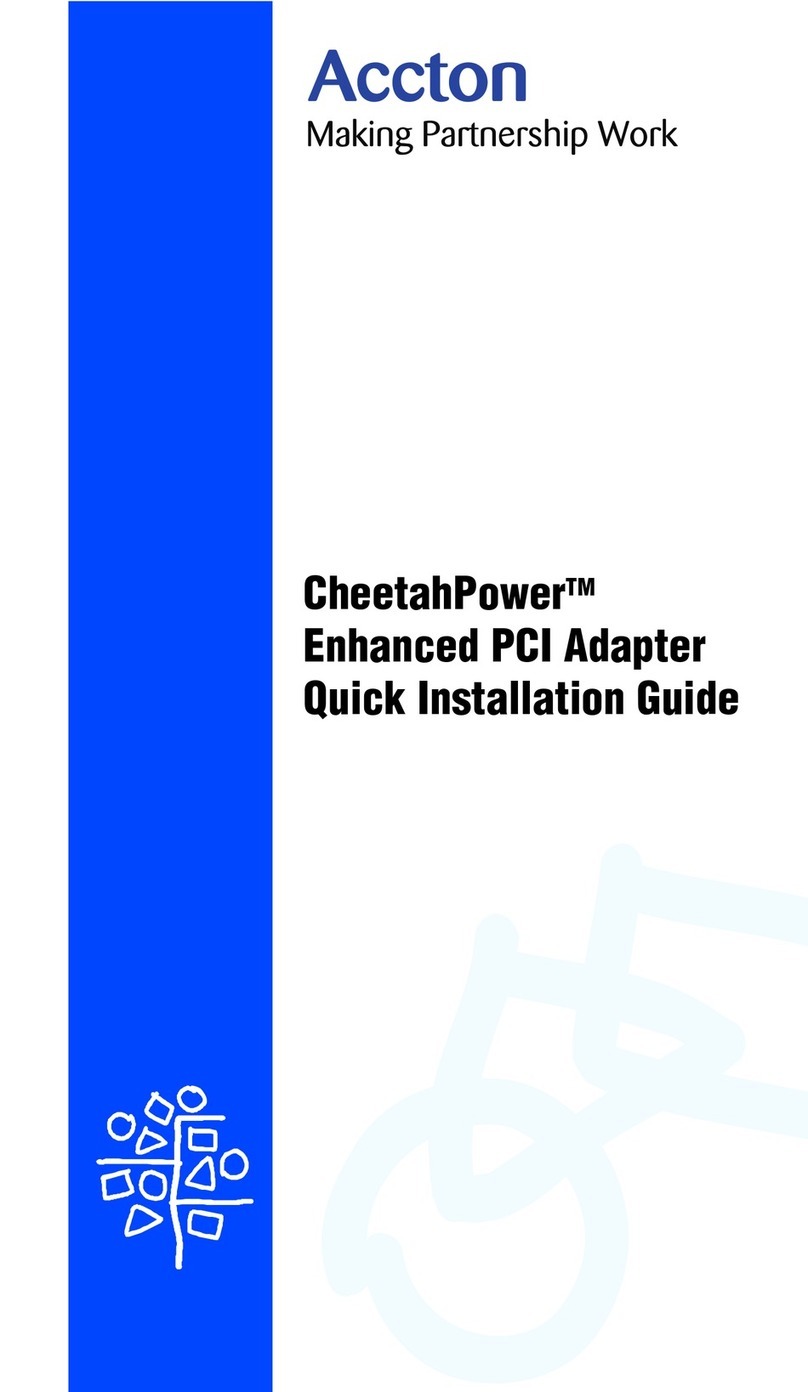
Accton Technology
Accton Technology CheetahPower Quick installation guide
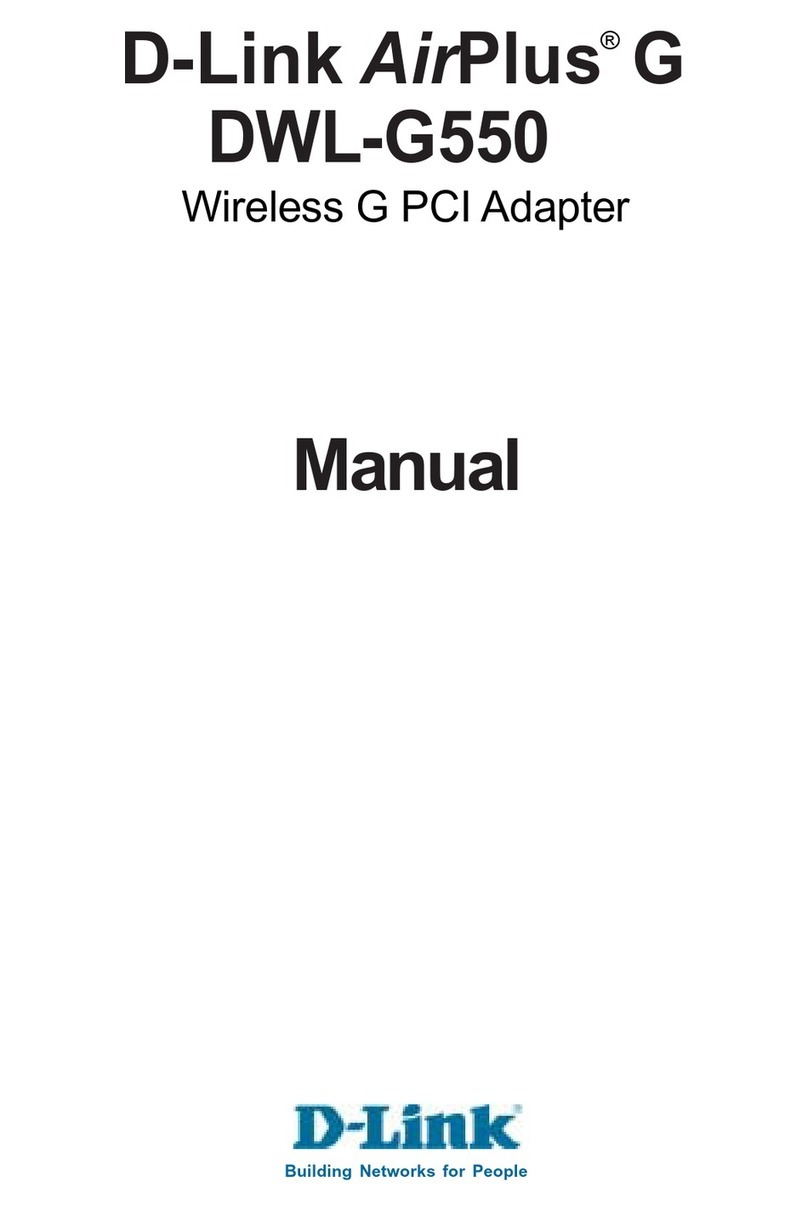
D-Link
D-Link DWL-G550 manual
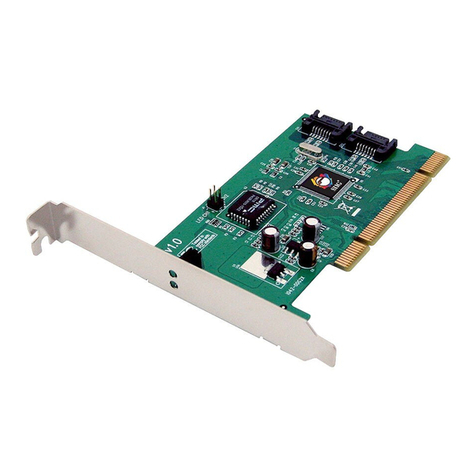
SIIG
SIIG SC-SA0012-S1 Quick installation guide
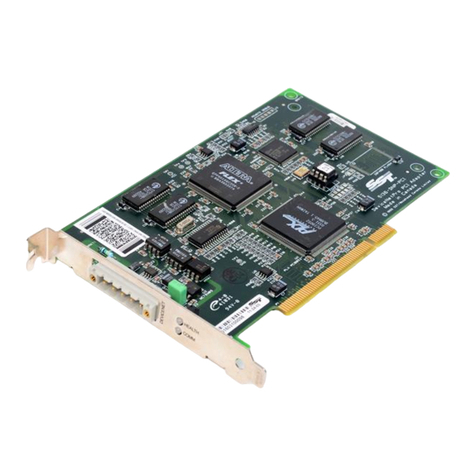
SST
SST 5136-DNP-PCI Hardware reference
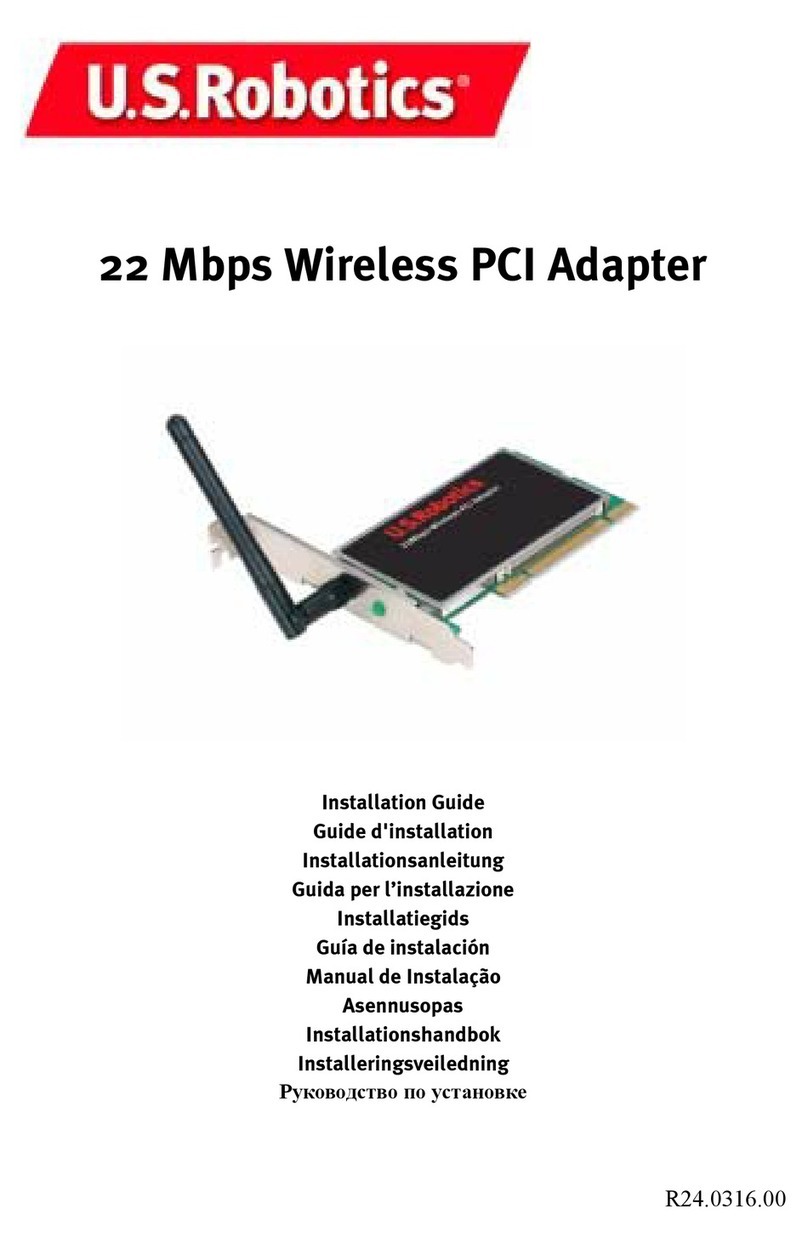
US Robotics
US Robotics USR2216 installation guide
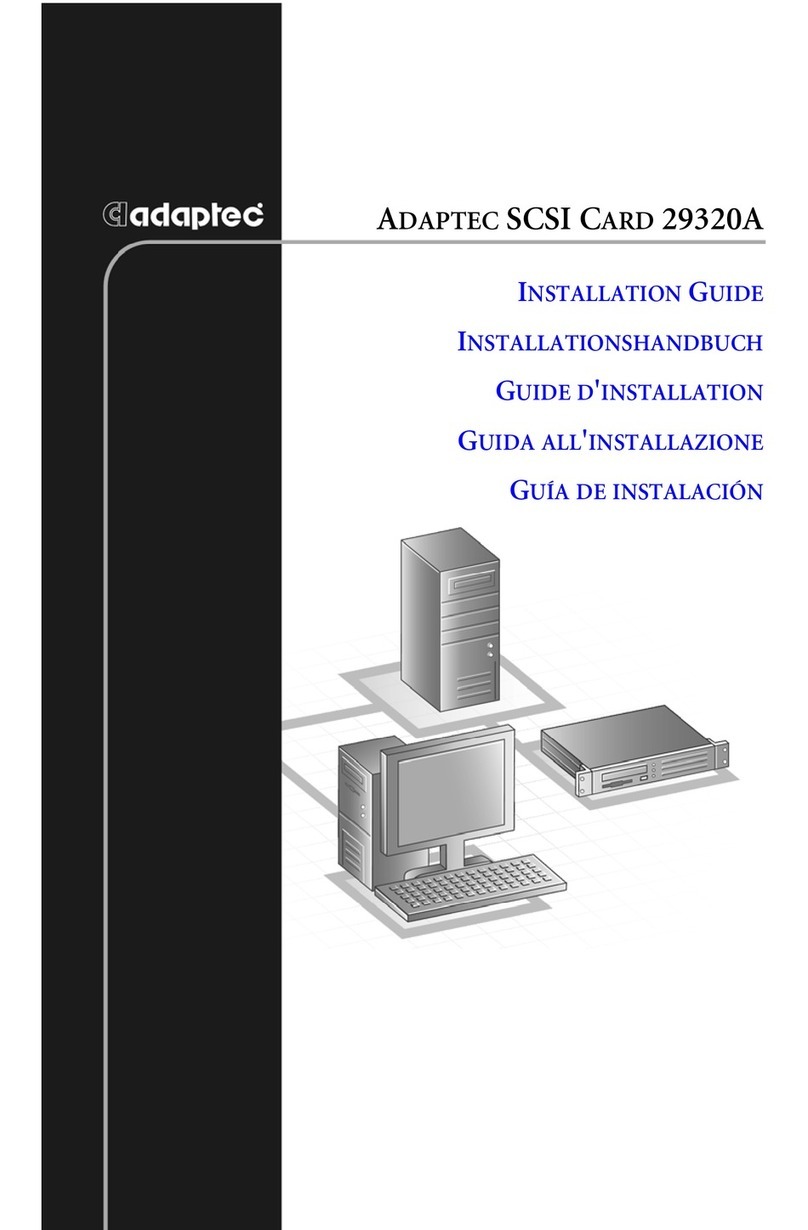
Adaptec
Adaptec 29320ALP-R - SCSI Card Storage Controller U320 320... installation guide
